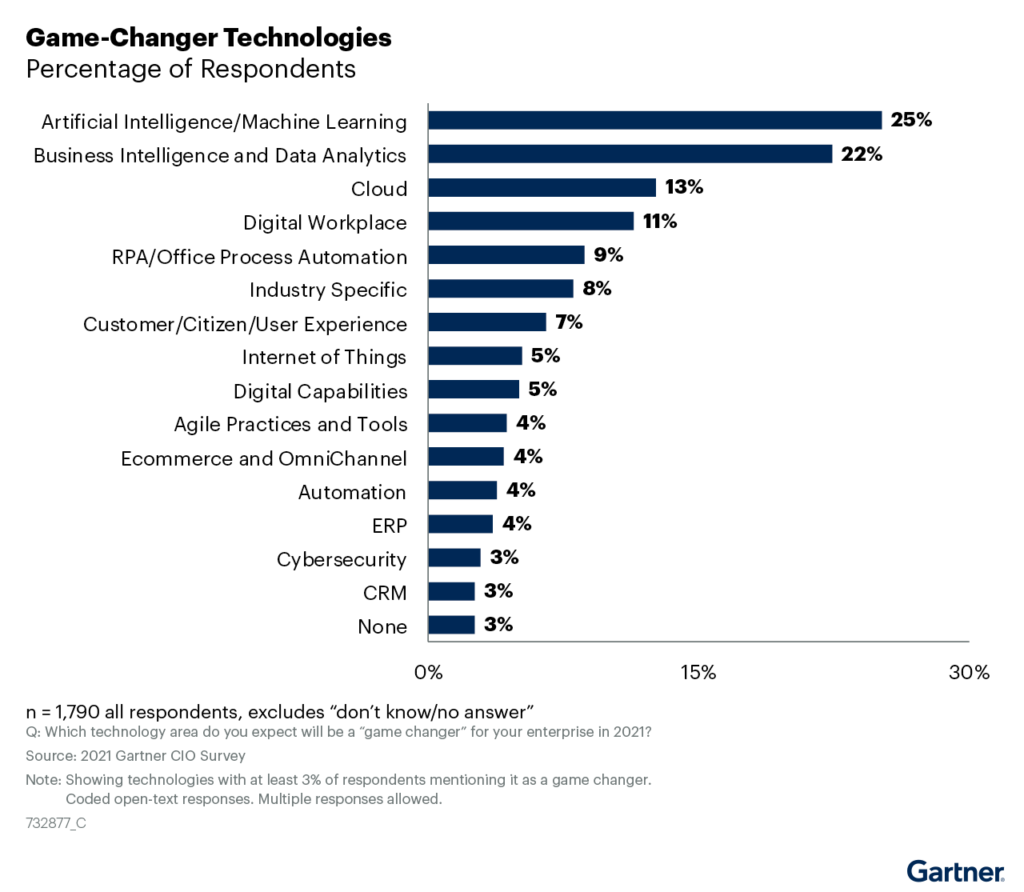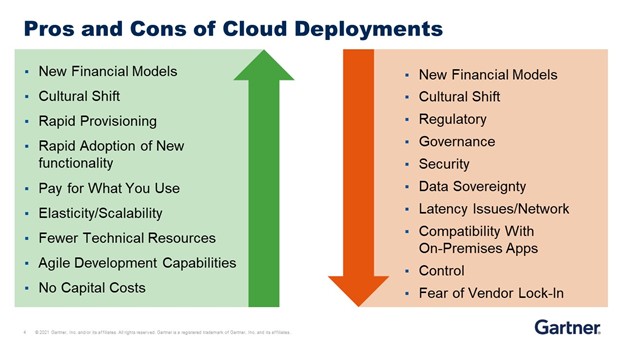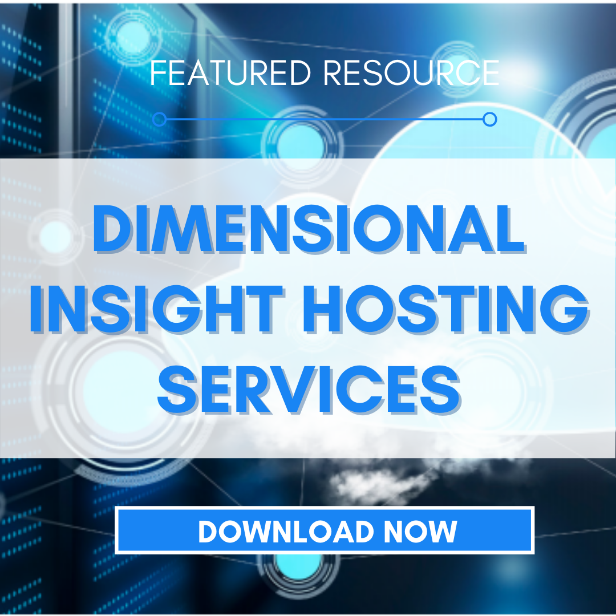If you ask most anyone about moving their software to the cloud, they’ll not only know what you are talking about, more often than not, they will be doing so themselves. It’s a trend that started long before the pandemic hit. But recently, the trend seems to have picked up its pace. In the “Flexera 2021, State of the Cloud Report,” Flexera interviewed 750 “global cloud decision-makers” about their plans for the cloud, including asking how COVID-19 has impacted their plans. 9 out of 10 of these companies say the pandemic has accelerated their plans. It’s no surprise the pandemic has accelerated their plans to move to the cloud. The pandemic caused many offices to close as employees began working from home, eliminating the need for (even the access to) on-premises hardware, software, and the staff to run them. Being able to access one’s software in the cloud suddenly became very important.
Just how vital has moving analytics to the cloud become? Figure 1 from “Market Guide for 5G Network Ecosystem Platform Providers” [1] includes this bar chart showing Enterprise CIOs expect analytics to be the number two “game changer” technology in 2021. Cloud follows immediately at number three. What about cloud analytics?

Figure 1
Laurence Goasduff predicted cloud analytics would be not just a priority but “essential.” Here is an excerpt from his article “Gartner Top 10 Trends in Data and Analytics for 2020,” ‘Trend 6: Cloud is a given.’
“By 2022, public cloud services will be essential for 90% of data and analytics innovation.
As data and analytics move to the cloud, data and analytics leaders still struggle to align the right services to the right use cases, which leads to unnecessary increased governance and integration overhead.
The question for data and analytics is moving from how much a given service costs to how it can meet the workload’s performance requirements beyond the list price.
Data and analytics leaders need to prioritize workloads that can exploit cloud capabilities and focus on cost optimization and other benefits such as change and innovation acceleration when moving to the cloud.”
The pandemic caused many enterprise initiatives to be postponed but did not slow the trend to move analytics to the cloud. If you are questioning whether to move your analytics to the cloud or not, the following advantages to cloud hosting analytics may just convince you to act now.
Benefits
Figure 2 shows the pros and cons of cloud deployments, according to Gartner 2021 “Data and Analytics Essentials: Cloud,” [2]

Figure 2
Items listed on the “Cons” side might be dealt with in the planning stage and via well-defined and flexible contracts with your CSP. Let’s look at some of the “Pros” — or advantages — in detail.
New Financial Models
Long-term hardware failures can cost hundreds of thousands of dollars in some cases. As owners of the server hardware that hosts your software, cloud service providers (CSPs) take the risk, and their customers relax. Companies that use cloud hosting no longer worry about outages. Accounting focus changes from capital expenditures to operating expenses.
Cultural Shift
In a capital expenditure mindset, buying hardware and software upgrades consume a large portion of the budget. When companies move to cloud analytics, there is no longer an incentive to stay on old software versions to save money. Instead, CSPs keep hardware and software up to date, and subscribers pay incremental fees for these types of upgrades. Because of these changes, there is a cultural shift. Perceptions about what is fast and what is slow change. It is not a good use of time to work on an outdated system using outdated software. With their software in the cloud, employees can focus on innovation instead of just getting by.
Rapid Provisioning
Time is money. CSPs have software and hardware experts working for you, so you can do what you do best: run your core business. And CSPs can provide server hardware and software configurations fine-tuned to run software in an optimized manner.
Rapid Adoption of New Functionality
Your IT staff is not required to do tasks associated with purchasing and maintaining hardware on-premises when you host in the cloud. Hosting in the cloud, therefore, frees up time for IT staff to focus on other work. Your staff works elsewhere as your cloud service provider does the job of keeping the hardware and software running.
Installation time disappears for all intents and purposes. And your employees will spend no time on upgrades.
Pay for What You Use
Figuring out how much computer memory and speed to buy for on-premises installations can be challenging. Determining this usage without using new software can be even more difficult as users ramp up their understanding of the software and ability to use it. Buyers may attempt to start with small configurations and add on later, risking a situation where productivity halts as systems are overloaded. Or they may try to buy a more extensive setup that users will grow into, risking paying for unused resources. When companies move their analytics to the cloud, they can pay as they go and adjust capacity and cost on an as-needed basis.
Elasticity/Scalability
The experiences of businesses over the past year and the pandemic are good examples of how quickly the business environment can change. Companies need to be agile to survive. In the cloud, your hosting services can promptly grow or shrink to adjust to your changing needs. When you move your analytics to the cloud, the size and performance of the server that hosts your software are flexible, providing agility and scalability. On the flip side, when you opt to host your data analytics software in-house, users may feel “stuck” and restricted by what you have purchased.
Fewer Technical Resources
Cloud analytics offload the responsibility for the configuration and operation of servers, storage, the network, and data centers. Offloading this responsibility allows staff to focus more time on essential objectives. At its simplest, the CSPs will enable you to continue to operate your software as you have before, just in the cloud instead of on-premises, freeing you of system maintenance tasks.
Agile Development Capabilities
It is expensive and time-consuming to build software testing and development infrastructure in-house. Cloud hosting services enable lower barriers to entry for this innovation and prototyping.
No Capital Costs
Hosting in the cloud costs less upfront than purchasing the hardware to host in-house. This kind of cost-saving occurs again when it comes time to upgrade or buy more hardware for expansion purposes. Companies that use cloud hosting do not have to outlay cash all upfront at these times.
Also, airflow and cooling are two significant concerns when planning a server room. The hardware used in a server room generates a lot of heat. To prevent this equipment from overheating, one must control the room temperature and humidity levels. Environmental control systems control the temperature and humidity – these can be expensive to operate. When you move to the cloud, you no longer have to pay to power on-premises servers nor pay to maintain their environment.
Are you ready to move to the cloud?
Dimensional insight has two options for the cloud: InterReport (SaaS) and DI Cloud (PaaS). With InterReport, our staff handles all tasks associated with operation and maintenance: data ingestion, ETL, content creation, standard reports, portal pages, and end-user application support. With DI Cloud, Dimensional Insight provides machines running Diver Platform, but customers have access to Workbench and are responsible for Diver Platform implementation, development, and administration. To learn more about Dimensional Insight cloud options, you can read about them on our website or download the Dimensional Insight Hosting Services datasheet PDF and read offline.
[1] Gartner, ‘Market Guide for 5G Network Ecosystem Platform Providers’, Sylvain Fabre, January 04, 2021
[2] Gartner, ‘Data and Analytics Essential: Cloud’, Adam Ronthal, April 29, 2021
- Meet the Dimensional Insight Team: Gabrielle Amarosa - December 1, 2022
- What You Need to Know About President Biden’s Marijuana Pardon - November 2, 2022
- How to Ace this Year’s OND - September 27, 2022




